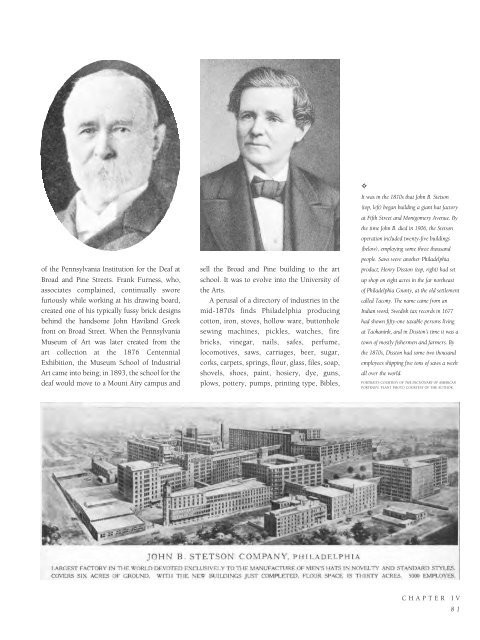Historic Philadelphia
An illustrated history of the city of Philadelphia, paired with the histories of companies, families and organizations that make the region great.
An illustrated history of the city of Philadelphia, paired with the histories of companies, families and organizations that make the region great.
Create successful ePaper yourself
Turn your PDF publications into a flip-book with our unique Google optimized e-Paper software.
of the Pennsylvania Institution for the Deaf at<br />
Broad and Pine Streets. Frank Furness, who,<br />
associates complained, continually swore<br />
furiously while working at his drawing board,<br />
created one of his typically fussy brick designs<br />
behind the handsome John Haviland Greek<br />
front on Broad Street. When the Pennsylvania<br />
Museum of Art was later created from the<br />
art collection at the 1876 Centennial<br />
Exhibition, the Museum School of Industrial<br />
Art came into being; in 1893, the school for the<br />
deaf would move to a Mount Airy campus and<br />
sell the Broad and Pine building to the art<br />
school. It was to evolve into the University of<br />
the Arts.<br />
A perusal of a directory of industries in the<br />
mid-1870s finds <strong>Philadelphia</strong> producing<br />
cotton, iron, stoves, hollow ware, buttonhole<br />
sewing machines, pickles, watches, fire<br />
bricks, vinegar, nails, safes, perfume,<br />
locomotives, saws, carriages, beer, sugar,<br />
corks, carpets, springs, flour, glass, files, soap,<br />
shovels, shoes, paint, hosiery, dye, guns,<br />
plows, pottery, pumps, printing type, Bibles,<br />
✧<br />
It was in the 1870s that John B. Stetson<br />
(top, left) began building a giant hat factory<br />
at Fifth Street and Montgomery Avenue. By<br />
the time John B. died in 1906, the Stetson<br />
operation included twenty-five buildings<br />
(below), employing some three thousand<br />
people. Saws were another <strong>Philadelphia</strong><br />
product; Henry Disston (top, right) had set<br />
up shop on eight acres in the far northeast<br />
of <strong>Philadelphia</strong> County, at the old settlement<br />
called Tacony. The name came from an<br />
Indian word; Swedish tax records in 1677<br />
had shown fifty-one taxable persons living<br />
at Taokanink, and in Disston’s time it was a<br />
town of mostly fishermen and farmers. By<br />
the 1870s, Disston had some two thousand<br />
employees shipping five tons of saws a week<br />
all over the world.<br />
PORTRAITS COURTESY OF THE DICTIONARY OF AMERICAN<br />
PORTRAITS. PLANT PHOTO COURTESY OF THE AUTHOR.<br />
CHAPTER IV<br />
81
















